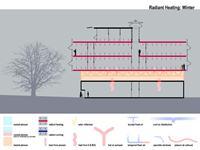Thermally Active Surface in Architecture

This body of research focuses on the new role of thermally active surfaces in architecture in the discipline's work towards low-to-no energy consumption buildings. In this transformation of energy and building practices, the thermal conditioning of a building is decoupled from the ventilation system by using the mass of the building itself as the thermal system rather than air.
The Upjohn grant has significantly accelerated the production of the first book manuscript, Thermally Active Surfaces in Architecture, that combines parallel strains of research related to thermally active surfaces: the historical and social construction of the technological momentum of air-conditioning and thermally active surfaces, the documentation and illustration of the physiological and thermodynamic basis of thermally active surfaces, the elucidation of changes and amendments to professional practice and the building industry implied with this technique, ten case studies that focus on the illustration/documentation on the systems, performance, and constructability of each project of these case studies. This report summarizes the book and its organization that documents the multi-faceted strains of research on thermally active surfaces.


Add comment
Log in to post comments